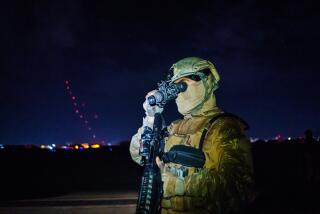Standing U.S. Peace Force Urged : Military: Officials disagree, contending present structure is adequate for post-Cold War assignments.
- Share via
WASHINGTON — With U.S. troops engaged in another major humanitarian venture, the Pentagon is coming under new criticism for refusing to designate peacekeeping as a key U.S. mission in the post-Cold War world or to train specific units for multinational operations.
Critics aren’t broadly faulting America’s performance in Somalia or similar relief operations in Kurdistan, Bangladesh and South Florida recently. But they say there have been some visible flaws that designating and training a peacekeeping force might have averted.
In the Kurdistan operation, for example, some argued that the military should have deployed its forces faster. In South Florida, residents complained that U.S. troops did not seem to be aware of the real needs of hurricane victims.
And in Panama, where American troops carried out relief operations after the overthrow of strongman Manuel A. Noriega, they often were hampered by a lack of Spanish-language speakers and knowledge of local conditions.
Pentagon officials oppose the sweeping changes called for by some defense experts, contending that the services can handle peacekeeping assignments effectively under the present structure and that designating specific units for peacekeeping duty would only restrict the military’s flexibility.
But defense experts argue that top U.S. commanders are being shortsighted in refusing to make specific adjustments for their new role.
The military, they say, should develop more sophisticated doctrines on the use of force by peacekeepers in various situations; on methods of compelling belligerents to stop fighting, and on ways high-technology weapons can be used without civilian casualties.
And these experts say U.S. field units need much more training in dealing with large civilian populations, reacting when confronted by mobs, speaking local languages and understanding local politics.
Barry Blechman, co-director of the Henry L. Stimson Center, a Washington think tank, argues that training specific combat units to carry out U.N.-related missions could improve the military’s performance and even help win extra appropriations.
“I don’t understand why the U.S. military doesn’t look at the peacekeeping mission seriously,” Blechman says. “It’s a force-builder,” he insists. “If they looked at it as a new mission, you could justify all sorts of stuff in their budgets.”
The debate is expected to intensify as the new Administration, Congress and the defense community begin a full reassessment of the proper size and structure of America’s armed forces in a world that now has just one superpower.
Congress already is pressing the Pentagon to designate units for peacekeeping and humanitarian duty and to develop appropriate doctrines, equipment and training procedures.
“This is as important an approach for safeguarding national security as more traditional ways,” one strategist says. “If we have units available for these kinds of missions, it reduces the prospect that we will have to send U.S. troops into full-scale combat.”
President-elect Bill Clinton has gone even further, suggesting that the United States explore creating a voluntary U.N. rapid-deployment force “to deter aggression against small states and to protect humanitarian relief shipments.”
Blechman and other advocates of the new concept cite several ways in which the special U.S. units could be used, including early interdiction of the flow of weapons into potential tinderboxes such as Bosnia-Herzegovina.
Blechman argues that Washington already has the technical wherewithal for such work, including acoustic and infrared technology, new radar aircraft and remote-controlled vehicles with cameras.
For example, the Army could establish special battalions with sensitive monitoring equipment to keep tabs on arms traffic in sensitive regions and to block the transfer of arms to warring factions. The Navy also could revive small craft units to patrol rivers and coasts.
John H. Henshaw, another Stimson defense scholar, points out that while the amphibious landing in Somalia was hailed as a textbook operation by the Pentagon, it was essentially the same procedure the Marines prescribed for taking Iwo Jima in World War II.
It may be that the Marines need to revise their procedures for less hazardous operations, such as landing in Mogadishu, he suggests.
Pentagon planners, however, argue that the existing structure enables them to tailor their forces to a specific mission by drawing on those units best suited to perform it. By contrast, they say, a designated peacekeeping force could never be that versatile.
Also, Pentagon officials say, the military already has specialists who can do many of the tasks cited by critics. For instance, Navy Seals and Army Special Forces, psychological operations and civil affairs units have personnel trained in languages, customs and special operations techniques.
But critics counter that except for some Special Forces units, U.S. troops receive scant, if any, instruction in such subjects. American troops bound for Somalia, for example, were handed a pamphlet-sized primer on these issues and taught to say “Halt” in Somali.
Henshaw says U.S. forces also need to learn more about how to work as part of a multinational coalition, rather than primarily operating on their own, as they did in the Persian Gulf War and are doing in the Somali operation.
Military leaders are expected to give a nod in the new direction early next year in a report on revamping the roles and missions of the services for the post-Cold War world. The document is expected to suggest some modest restructuring, well short of what Blechman has proposed.
More to Read
Sign up for Essential California
The most important California stories and recommendations in your inbox every morning.
You may occasionally receive promotional content from the Los Angeles Times.










